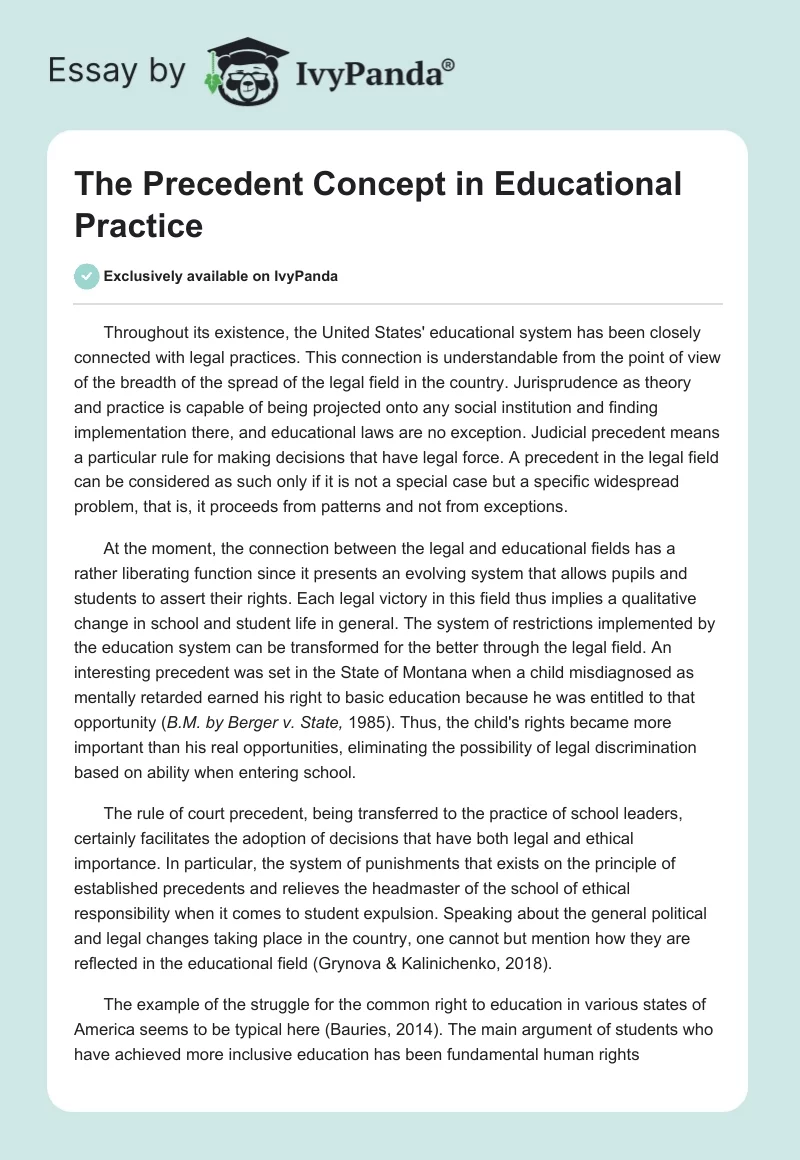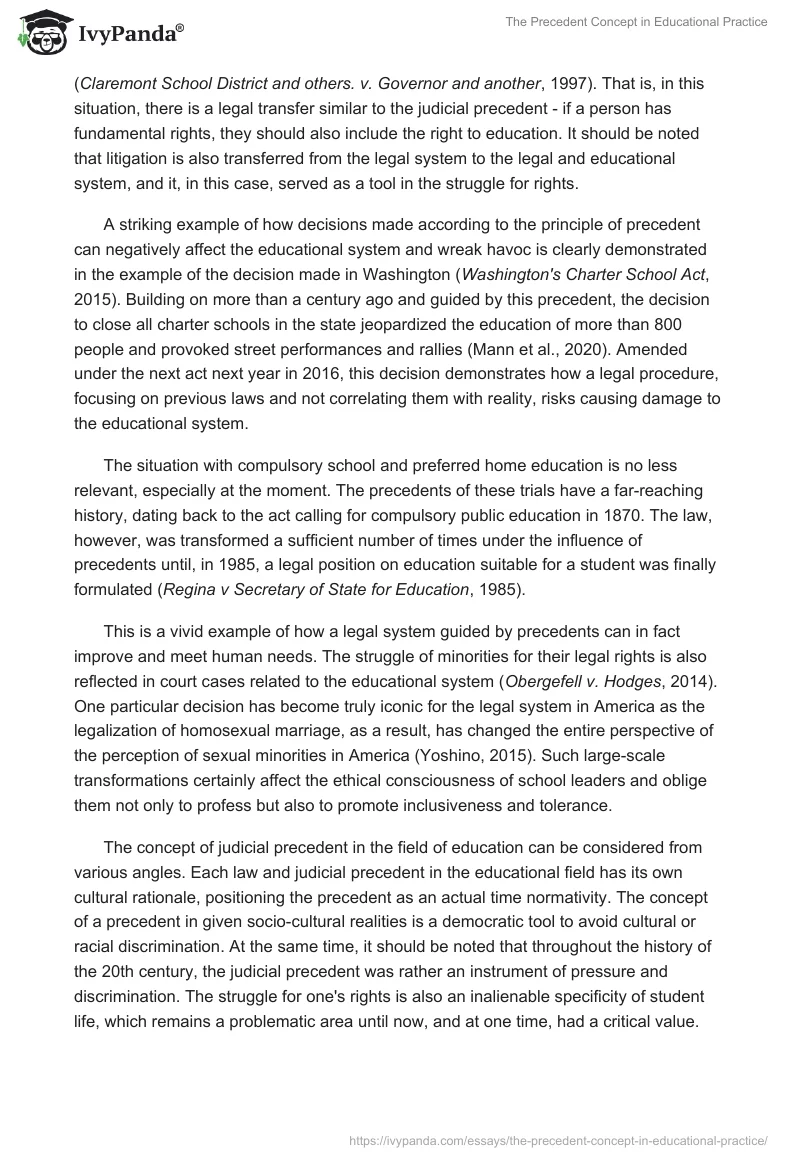Throughout its existence, the United States’ educational system has been closely connected with legal practices. This connection is understandable from the point of view of the breadth of the spread of the legal field in the country. Jurisprudence as theory and practice is capable of being projected onto any social institution and finding implementation there, and educational laws are no exception. Judicial precedent means a particular rule for making decisions that have legal force. A precedent in the legal field can be considered as such only if it is not a special case but a specific widespread problem, that is, it proceeds from patterns and not from exceptions.
At the moment, the connection between the legal and educational fields has a rather liberating function since it presents an evolving system that allows pupils and students to assert their rights. Each legal victory in this field thus implies a qualitative change in school and student life in general. The system of restrictions implemented by the education system can be transformed for the better through the legal field. An interesting precedent was set in the State of Montana when a child misdiagnosed as mentally retarded earned his right to basic education because he was entitled to that opportunity (B.M. by Berger v. State, 1985). Thus, the child’s rights became more important than his real opportunities, eliminating the possibility of legal discrimination based on ability when entering school.
The rule of court precedent, being transferred to the practice of school leaders, certainly facilitates the adoption of decisions that have both legal and ethical importance. In particular, the system of punishments that exists on the principle of established precedents and relieves the headmaster of the school of ethical responsibility when it comes to student expulsion. Speaking about the general political and legal changes taking place in the country, one cannot but mention how they are reflected in the educational field (Grynova & Kalinichenko, 2018).
The example of the struggle for the common right to education in various states of America seems to be typical here (Bauries, 2014). The main argument of students who have achieved more inclusive education has been fundamental human rights (Claremont School District and others. v. Governor and another, 1997). That is, in this situation, there is a legal transfer similar to the judicial precedent – if a person has fundamental rights, they should also include the right to education. It should be noted that litigation is also transferred from the legal system to the legal and educational system, and it, in this case, served as a tool in the struggle for rights.
A striking example of how decisions made according to the principle of precedent can negatively affect the educational system and wreak havoc is clearly demonstrated in the example of the decision made in Washington (Washington’s Charter School Act, 2015). Building on more than a century ago and guided by this precedent, the decision to close all charter schools in the state jeopardized the education of more than 800 people and provoked street performances and rallies (Mann et al., 2020). Amended under the next act next year in 2016, this decision demonstrates how a legal procedure, focusing on previous laws and not correlating them with reality, risks causing damage to the educational system.
The situation with compulsory school and preferred home education is no less relevant, especially at the moment. The precedents of these trials have a far-reaching history, dating back to the act calling for compulsory public education in 1870. The law, however, was transformed a sufficient number of times under the influence of precedents until, in 1985, a legal position on education suitable for a student was finally formulated (Regina v Secretary of State for Education, 1985).
This is a vivid example of how a legal system guided by precedents can in fact improve and meet human needs. The struggle of minorities for their legal rights is also reflected in court cases related to the educational system (Obergefell v. Hodges, 2014). One particular decision has become truly iconic for the legal system in America as the legalization of homosexual marriage, as a result, has changed the entire perspective of the perception of sexual minorities in America (Yoshino, 2015). Such large-scale transformations certainly affect the ethical consciousness of school leaders and oblige them not only to profess but also to promote inclusiveness and tolerance.
The concept of judicial precedent in the field of education can be considered from various angles. Each law and judicial precedent in the educational field has its own cultural rationale, positioning the precedent as an actual time normativity. The concept of a precedent in given socio-cultural realities is a democratic tool to avoid cultural or racial discrimination. At the same time, it should be noted that throughout the history of the 20th century, the judicial precedent was rather an instrument of pressure and discrimination. The struggle for one’s rights is also an inalienable specificity of student life, which remains a problematic area until now, and at one time, had a critical value.
References
Bauries, S. R. (2014). Common law constitutionalism for the right to education. Georgia Law Review, 48(4), 951-1016.
B.M. by Berger v. State, 84 U.S. 274 (1985). Web.
Claremont School District and others. v. Governor and another, 97 U.S. 001, (1997). Web.
Grynova, M., & Kalinichenko, I. (2018). Trends in inclusive education in the USA and Canada. Comparative Professional Pedagogy, 8(2). Web.
Mann, B., Bennett, H., & Rogers, A. (2020). Gentrification, charter schools, and enrollment patterns in Washington, DC: Shared growth or new forms of educational inequality? Peabody Journal of Education 95(3), 211-228. Web.
Obergefell et. al v. Hodges, director, Ohio Department of Health, et al., 14 U.S. 556, (2014). Web.
Regina v Secretary of State for Education ex parte Talmud Torah Machzikei Hadass. (1985). Web.
Washington’s Charter School Act (RCW 28A. 710), (2015).
Yoshino, K. (2015). A new birth of freedom?: Obergefell v. Hodges. Harvard Law Review, 129(147), 147-180.


